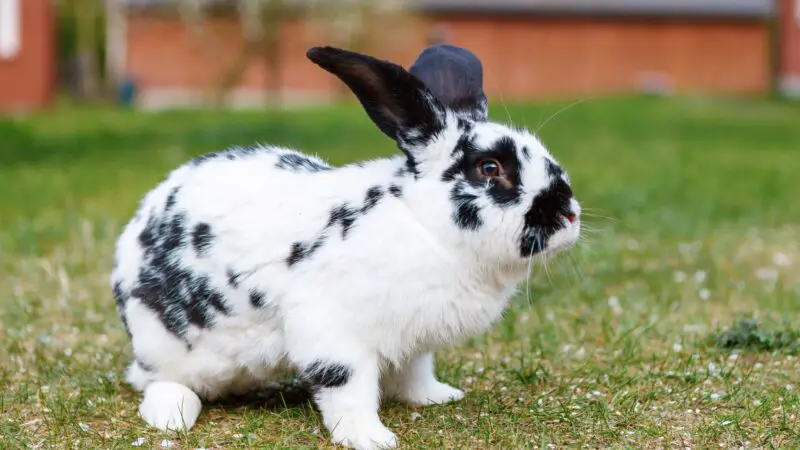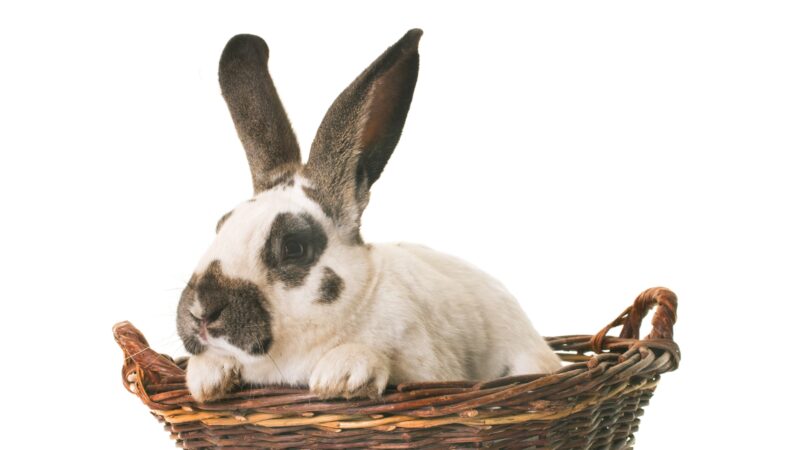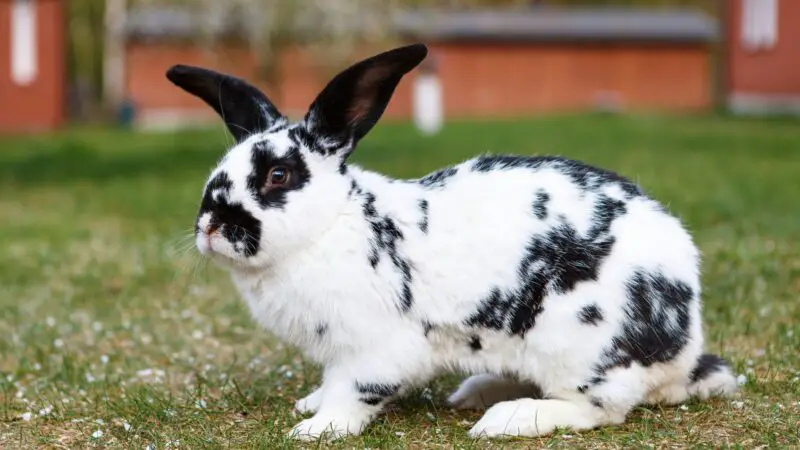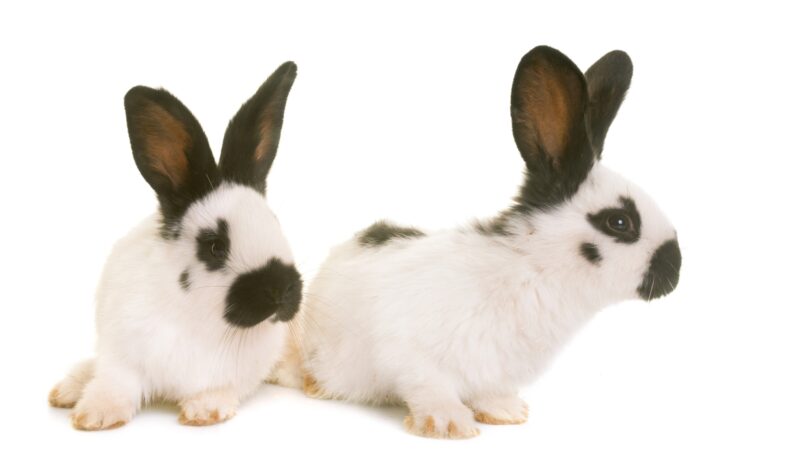Rabbits can come in different sizes, coat types, colors, and sizes. There are 49 recognized rabbit breeds categorized as 4 class or 6 class wherein smaller-sized breeds belong to the former while the larger-sized ones are considered the latter. One such 6 class rabbit breed is the Checkered Giant rabbit.
Checkered Giant rabbit is a rabbit breed known for its large size, as it is the second heaviest rabbit breed, as well as for its distinctive gray or black body markings, hence its name.
Checkered Giant rabbits are primarily raised for fur and as show rabbits. Although rarely some breeders also raise them for meat production.
This article discusses everything you need to know about the checkered giant rabbit, including its history, physical attributes, distinctive characteristics, temperament, how to raise and breed them, and other interesting information. Read further for more!
Checkered Giant Rabbit History

The existence of large, spotted rabbits in Europe was known since the middle of the 19th century. These rabbits then boomed in popularity in Germany, which is why they are also referred to as the Great German Spotted rabbits, where rabbit breeding enthusiasts began crossbreeding them with other rabbit breeds to increase their sizes.
In 1904, Otto Reinhardt crossbred the Great German Spotted rabbit to a black Flemish Giant rabbit, although some experts would say the latter was a gray Flemish Giant rabbit, to produce what we know as the Checkered Giant rabbit today.
The Checkered Giant eventually became popular across Europe then, in 1910, it was introduced to the United States. At that time, the required pattern for the spots should have a distinguishable butterfly-shaped marking with wings that circle the nose, body, and forehead. Due to this marking, they were also referred to as the Giant Papillon in Europe.
The American Rabbit Breeders Association officially recognized the Checkered Giant rabbit as a breed in 1919 since it managed to pass their standard of perfection. The organization itself deemed this breed as the “rabbit beautiful.”
What Is a Checkered Giant Rabbit?
What Do Checkered Giant Rabbits Look Like?
Checkered Giant rabbit comes in two different color morphs: black (white with black-colored spots, bands, and other markings) and blue (white with gray-colored spots, bands, and other markings). Its body is long, slender, and semi-arched in shape. It also has thick medium-length fur, broad ears, and a wide head.
The Checkered Giant rabbit has a distinctive black or gray band that extends from its black or gray-colored ears to its dorsal line found along the length of its body and spine, sometimes also extending as far as its tail.
It also has a black or gray-ringed eye and mouth, as well as a random pattern of black or gray spots on its body.
How Long Does a Checkered Giant Rabbit Live?
Checkered Giant rabbits can live as long as 10 years. But on average, their lifespan is somewhere between 5 to 8 years, which is also the normal life expectancy of rabbits when taken care of as pets.
What Do Checkered Giant Rabbits Eat?
Checkered Giant rabbits can eat a variety of plants and plant material such as grains, root crops, green feeds, fruits, vegetables, and roughages, but most of their diet consists of hay such as timothy, alfalfa, and lespedeza.
Rabbit raisers will usually add protein supplements such as peanut meal and soybean meal or even use commercialized feeds instead.
How Big Do Checkered Giant Rabbits Grow?
An adult Checkered Giant rabbit is 25 inches in length and 30 inches in standing height.
Are Checkered Giant Rabbits a Heavy Breed?
Checkered Giant rabbits are a heavy breed. They are the second heaviest rabbit breed after the Flemish Giant rabbits.
The minimum weight of the Checkered Giant rabbit is 5 kilograms for mature bucks or male rabbits, and 5.4 kilograms for mature does or female rabbits. Both sexes have no maximum weight.
What Is Checkered Giant Rabbit Known For?
Although it is a heavy breed, the Checkered Giant rabbit is primarily raised for their fur and ornamental purposes, such as participating in rabbit exhibitions. They can be raised for meat, but this is rare among breeders.
Where Do Checkered Giant Rabbits Originate?
Checkered Giant rabbits are believed to be from Europe, specifically Germany, where it was a product of a crossbreeding between a Great German Spotted rabbit and a Flemish Giant rabbit.
What Are the Distinct Characteristics of a Checkered Giant Rabbit?
Checkered Giant rabbit mostly known for its distinctive black or gray markings and large but slender, hare-like body.
Checkered Giant Rabbit Temperament
Checkered Giant rabbits are considered a running breed since they are highly active and energetic, which is why they require a lot of space to move around. When they’re not out and about, they usually have a calm temperament and a good nature in them.
Are Checkered Giant Rabbits Aggressive?

Checkered Giant rabbit are not aggressive, but they can be prone to aggression when they are handled irresponsibly or incorrectly. Newly adopted or bought Checkered Giant rabbits can also be standoffish as they won’t let you touch them, but will become friends once they get used to you and become comfortable with your presence.
How Much Do Checkered Giant Rabbits Cost?
Checkered Giant rabbits are usually priced around $50 to $80, depending on the breeder. Show-quality rabbits would most likely cost more, around $75 to $300 since they cost more to raise.
Checkered Giant Rabbit Care Tips

1. Diet
Rabbits should be provided with an unlimited amount of clean, fresh hay, preferably timothy or alfalfa. As much as possible, don’t add anything to the hay. Avoid feeding them food with high sugar counts.
You can also feed them one-fourths to a one-third cup of rabbit pellets daily, usually timothy hay-based. Make sure they don’t include any corn, seeds, nuts, or any other colored or crunchy pieces. Add 2 cups of dark leafy greens to their diet. Only feed fruits as a treat and only in small pieces.
Provide your rabbits with a water bowl or sipper bottle for them to drink from. Remember to change their water daily and clean their water containers with hot, soapy water.
2. Caging and Exercise
The best time to allow your rabbit to go out of its enclosure is around dawn and dusk since that’s the time they’re most active. Make sure they get sufficient playtime and exercise to maintain their body condition.
3. Handling
Rabbits dislike being carried or picked up, but in necessary situations, handle them carefully, or else they can lash out at you. When handling, securely hold their back legs, then support their entire body from above and below, with their rear end sitting on your elbow.
4. Maintenance
Regularly sanitate their living areas by cleaning up stale food, spills, shedded fur, and other messes. Dispose of the contents of their litter box regularly and line them with new pelleted paper litter or newspaper shredding afterward.
5. Healthcare
Regularly visit your local veterinarian annually. Ensure that you have placed your rabbits inside a secure carrier, such as a cage when bringing them into clinics. Neutering or spaying can allow your bunny to live a longer, healthier life, but it’s not required.
Breeding Checkered Giant Rabbit
- Know your market by identifying the demand of your local wholesalers, restaurants, custom meat stores, and individual consumers. Although Checkered Giant rabbits are usually raised for their wool, you can also raise them for breeding stock, meat, and laboratory use.
- Once you know what you’re raising your rabbits for, you can now plan the size of your entire breeding operation. When purchasing your desired breeding stock, contact local rabbit clubs and local breeders. Make sure to ask before buying about the health and breeding records of the rabbits. The minimum production unit is 2 bucks, and 20 does.
- Construct a rabbitry by either building or converting an enclosed building. It should have proper heating and cooling systems, lighting, and ventilation. All rabbits should have their hutches or living spaces to live in.
- Nest boxes made out of wire mesh, non-treated wood, or sheet metal must be built inside the rabbitry to provide a secure place for does to give birth in. The space should be big enough for each doe and its litter, but also small enough to keep them all close together. Add wood shavings, straws, or other suitable materials as bedding.
- Checkered Giant rabbits can breed at around 7 months of age since they are particularly heavy breeds. Thus, will require more time to develop.
- Establish a breeding schedule based on 7-days intervals. Usually, rabbit producers will follow a 35-day breed-back schedule so that the does will not burn out easily. Note that one buck can service up to 10 does, but breeding shouldn’t be done more than 3 times a week.
- Does should be placed inside the buck’s cage when it’s time for breeding, not the other way around since does can be territorial against bucks. Mating usually occurs immediately after placing the doe and buck together. Afterward, the doe should be put back inside its cage.
- The average gestation period for a doe lasts up to 32 days. 28 days after breeding, transfer the nest box inside the doe’s hutch. After the doe has given birth, observe the newly-born kits and remove any dead ones. Remove the nest box from the hutch 5 to 21 days after birth. The young will be weaned in about 30 days.
Common Health Issues of Checkered Giant Rabbits

- Reproductive issues can include failure to conceive after mating due to either being overweight or because of not being able to produce for a long period of time. Does are also likely to contract uterine infection and cancer as they age. On the other hand, bucks, especially when they’re old, are more susceptible to heat, which can cause sterility for 60 to 90 days.
- Pasteurella multocida can cause infections in the eyes, nose, ears, and tear ducts of rabbits, as well as cause abscesses in their bones, internal organs, and skin tissues.
- Flea bites are also common occurrences as they target the fur and ear of the rabbits. Usually, they are not a cause of concern, but if left untreated, they can cause hair loss, itchiness, pain, and swelling.
- Myxomatosis is transmitted by mosquitoes and can cause a fatality, while Rabbit calicivirus disease is transmitted through urine, droppings, and secretions from the nose and eyes and can also cause death.
- Overgrown teeth are caused when rabbits are not chewing enough grass. It can cause severe pain and discomfort as well as weight loss.
